Ways to Defend Your Pipes from Cold Weather: Expert Advice
Ways to Defend Your Pipes from Cold Weather: Expert Advice
Blog Article
Everyone may have his or her own thinking when it comes to How To Avoid Freezing Pipes.

Winter can ruin your pipes, specifically by freezing pipelines. Right here's exactly how to avoid it from occurring and what to do if it does.
Introduction
As temperatures drop, the threat of icy pipelines increases, possibly causing pricey fixings and water damages. Comprehending how to prevent icy pipes is vital for homeowners in chilly environments.
Prevention Tips
Protecting prone pipelines
Wrap pipes in insulation sleeves or utilize warmth tape to safeguard them from freezing temperature levels. Concentrate on pipes in unheated or exterior locations of the home.
Heating strategies
Maintain interior rooms sufficiently warmed, specifically locations with pipes. Open cabinet doors to enable cozy air to flow around pipes under sinks.
How to determine icy pipelines
Search for reduced water flow from faucets, unusual odors or noises from pipelines, and noticeable frost on subjected pipes.
Long-Term Solutions
Architectural changes
Take into consideration rerouting pipelines far from outside walls or unheated areas. Include additional insulation to attics, cellars, and crawl spaces.
Upgrading insulation
Purchase premium insulation for pipes, attics, and walls. Appropriate insulation aids preserve consistent temperature levels and decreases the danger of frozen pipelines.
Securing Exterior Plumbing
Garden pipes and exterior taps
Separate and drain pipes yard hose pipes prior to wintertime. Install frost-proof spigots or cover exterior faucets with shielded caps.
Understanding Icy Pipes
What triggers pipelines to freeze?
Pipes ice up when exposed to temperatures below 32 ° F (0 ° C) for expanded durations. As water inside the pipes freezes, it broadens, taxing the pipe walls and potentially triggering them to break.
Dangers and problems
Icy pipelines can bring about supply of water interruptions, building damages, and pricey repairs. Ruptured pipelines can flood homes and cause comprehensive structural damage.
Signs of Frozen Piping
Recognizing icy pipes early can avoid them from breaking.
What to Do If Your Pipes Freeze
Immediate activities to take
If you think frozen pipelines, keep taps available to alleviate stress as the ice melts. Make use of a hairdryer or towels soaked in hot water to thaw pipelines gradually.
Conclusion
Stopping frozen pipelines requires positive actions and quick feedbacks. By understanding the reasons, signs, and preventive measures, home owners can protect their pipes throughout cold weather.
6 Proven Ways to Prevent Frozen Pipes and Protect Your Home
Disconnect and Drain Garden Hoses
Before winter arrives, start by disconnecting your garden hoses and draining any remaining water. Close the shut-off valves that supply outdoor hose bibs and leave the outdoor faucet open to allow any residual water to drain. For extra protection, consider using faucet covers throughout the colder months. It’s also important to drain water from any sprinkler supply lines following the manufacturer’s directions.
Insulate Exposed Pipes
Insulating your pipes is an effective way to prevent freezing. Pipe insulation is readily available at home improvement stores and is relatively inexpensive. Pay close attention to pipes in unheated areas such as the attic, basement, crawl spaces, or garage. Apply foam insulation generously to create a buffer against the cold. You can also wrap your pipes in heat tape or thermostat-controlled heat cables for added warmth.
Seal Air Leaks
Inspect your home for any cracks or openings that could let in cold air. Seal any holes around the piping in interior or exterior walls, as well as the sill plates where your home rests on its foundation. Additionally, make sure to keep your garage door closed unless you’re entering or exiting. Leaving it open creates a significant air leak that can lead to frozen pipes.
Allow Warm Air Circulation
During cold snaps, it’s essential to allow warm air to circulate evenly throughout your home. Leave interior doors ajar to promote better airflow. Open kitchen and bathroom cabinets to help distribute heat consistently around the rooms. If you have small children or pets, be sure to remove any household chemicals or potentially harmful cleaners from open cabinets for safety.
Let Faucets Drip
A small trickle of water can make a big difference in preventing ice formation inside your pipes. When temperatures drop significantly, start a drip of water from all faucets served by exposed pipes. This continuous flow helps prevent the water from freezing. Additionally, running a few faucets slightly can relieve pressure inside the pipes, reducing the chances of a rupture if the water inside does freeze.
https://choateshvac.com/6-proven-ways-to-prevent-frozen-pipes-and-protect-your-home/

I hope you enjoyed reading our piece about How To Avoid Freezing Pipes. Thank you so much for taking a few minutes to browse our blog. Sharing is nice. Helping others is fun. Thanks a bunch for your time. Please visit our website back soon.
Call Today Report this page